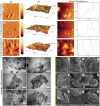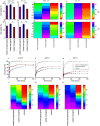MIL-125-based nanocarrier decorated with Palladium complex for targeted drug delivery
- PMID: 35840687
- PMCID: PMC9287414
- DOI: 10.1038/s41598-022-16058-w
MIL-125-based nanocarrier decorated with Palladium complex for targeted drug delivery
Abstract
The aim of this work was to provide a novel approach to designing and synthesizing a nanocomposite with significant biocompatibility, biodegradability, and stability in biological microenvironments. Hence, the porous ultra-low-density materials, metal-organic frameworks (MOFs), have been considered and the MIL-125(Ti) has been chosen due to its distinctive characteristics such as great biocompatibility and good biodegradability immobilized on the surface of the reduced graphene oxide (rGO). Based on the results, the presence of transition metal complexes next to the drug not only can reinforce the stability of the drug on the structure by preparing π-π interaction between ligands and the drug but also can enhance the efficiency of the drug by preventing the spontaneous release. The effect of utilizing transition metal complex beside drug (Doxorubicin (DOX)) on the drug loading, drug release, and antibacterial activity of prepared nanocomposites on the P. aeruginosa and S. aureus as a model bacterium has been investigated and the results revealed that this theory leads to increasing about 200% in antibacterial activity. In addition, uptake, the release of the drug, and relative cell viabilities (in vitro and in vivo) of prepared nanomaterials and biomaterials have been discussed. Based on collected data, the median size of prepared nanocomposites was 156.2 nm, and their biological stability in PBS and DMEM + 10% FBS was screened and revealed that after 2.880 min, the nanocomposite's size reached 242.3 and 516 nm respectively. The MTT results demonstrated that immobilizing PdL beside DOX leads to an increase of more than 15% in the cell viability. It is noticeable that the AST:ALT result of prepared nanocomposite was under 1.5.
© 2022. The Author(s).
Conflict of interest statement
The authors declare no competing interests.
Figures






References
-
- Shokri Z, et al. Elucidating the impact of enzymatic modifications on the structure, properties, and applications of cellulose, chitosan, starch and their derivatives: a review. Mater. Today Chem. 2022;24:100780. doi: 10.1016/j.mtchem.2022.100780. - DOI
-
- Seidi F, Saeb MR, Jin Y, Zinck P, Xiao H. Thiol-lactam initiated radical polymerization (TLIRP): scope and application for the surface functionalization of nanoparticles. Mini-Rev. Org. Chem. 2022;19:416–431. doi: 10.2174/1570193X18666210916165249. - DOI
-
- Keup C, et al. Longitudinal multi-parametric liquid biopsy approach identifies unique features of circulating tumor cell, extracellular vesicle, and cell-free DNA characterization for disease monitoring in metastatic breast cancer patients. Cells. 2021;10:212. doi: 10.3390/cells10020212. - DOI - PMC - PubMed
Publication types
MeSH terms
Substances
LinkOut - more resources
Full Text Sources
Research Materials
Miscellaneous

